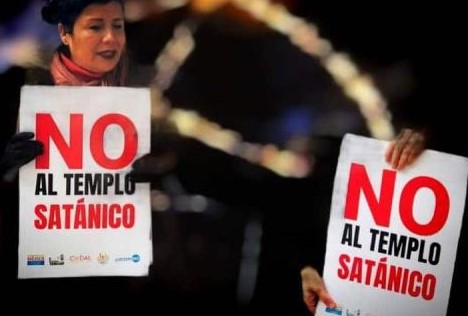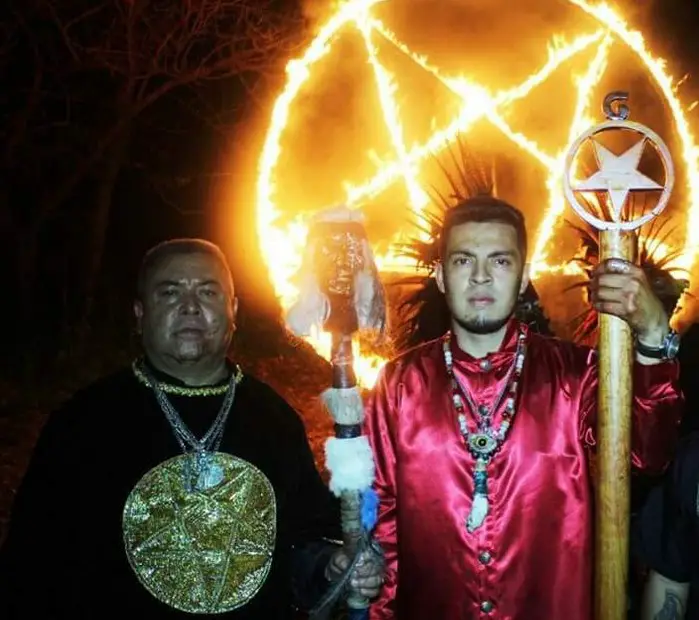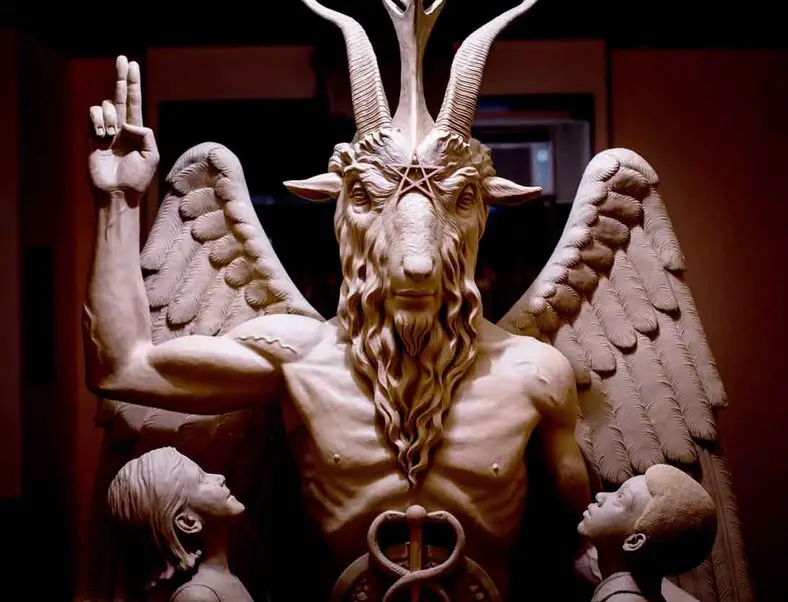Podcast: Play in new window | Download
Subscribe: Apple Podcasts | RSS
 It has raised a hellstorm of controversy since the announcement of its construction in late August of 2022, but it seems like Mexico’s first temple dedicated to Satan is scheduled to open in March of 2024. The person behind this effort is the Brujo Mayor or the “Head Sorcerer” in the town of Catemaco, Veracruz, a man by the name of Enrique Marthen Berdón. Before making the announcement, Berdón obtained all the necessary permits from the municipality to ensure the successful, problem-free construction of the temple in Catemaco’s Paraíso Dos neighborhood, far away from the city’s center. When all the necessary permissions were secured, Berdón and a group of self-described Satanists, witches, and various practitioners of the “dark arts” laid the foundation for their temple, the first openly satanic place of worship in the country of Mexico. They took water from 7 sacred lakes and 7 enchanted waterfalls nearby and mixed it with water from “The Seven Seas” to sprinkle on the foundation. The group also made 7 animal sacrifices and spread the blood from these creatures on the building site. In the formal inauguration ceremonies, there were rituals held in candlelight on a makeshift altar for the future temple. Women clad in red leather body suits and wearing horns on their heads flanked Enrique Berdón as he called upon the devil to bless their bold endeavor. Parts of this ceremony were filmed and to an unsuspecting person viewing these clips this all may seem like a big LARP. Some may think this is a way for this specific group to attract publicity or maybe even draw tourists to the area. However, this is not the case and the people behind Mexico’s first publicly declared satanic temple are dead serious. In the face of overwhelming opposition from local to national levels, the building project is on track to be complete by the target date of the first Friday in March of 2024.
It has raised a hellstorm of controversy since the announcement of its construction in late August of 2022, but it seems like Mexico’s first temple dedicated to Satan is scheduled to open in March of 2024. The person behind this effort is the Brujo Mayor or the “Head Sorcerer” in the town of Catemaco, Veracruz, a man by the name of Enrique Marthen Berdón. Before making the announcement, Berdón obtained all the necessary permits from the municipality to ensure the successful, problem-free construction of the temple in Catemaco’s Paraíso Dos neighborhood, far away from the city’s center. When all the necessary permissions were secured, Berdón and a group of self-described Satanists, witches, and various practitioners of the “dark arts” laid the foundation for their temple, the first openly satanic place of worship in the country of Mexico. They took water from 7 sacred lakes and 7 enchanted waterfalls nearby and mixed it with water from “The Seven Seas” to sprinkle on the foundation. The group also made 7 animal sacrifices and spread the blood from these creatures on the building site. In the formal inauguration ceremonies, there were rituals held in candlelight on a makeshift altar for the future temple. Women clad in red leather body suits and wearing horns on their heads flanked Enrique Berdón as he called upon the devil to bless their bold endeavor. Parts of this ceremony were filmed and to an unsuspecting person viewing these clips this all may seem like a big LARP. Some may think this is a way for this specific group to attract publicity or maybe even draw tourists to the area. However, this is not the case and the people behind Mexico’s first publicly declared satanic temple are dead serious. In the face of overwhelming opposition from local to national levels, the building project is on track to be complete by the target date of the first Friday in March of 2024.
While there have undoubtedly been secret places of so-called “devil worship” throughout Mexico across time, the Satanic Temple of Catemaco is the first one to be open to the public and brazenly declares itself as a place to worship Satan. Why is such a historic building being built in this relatively off-the-beaten-path town of 28,000 instead of in a place of a much larger population like Mexico City or Guadalajara? There are many important reasons for this. First, we need to look into why Catemaco is relevant.
 The town of Catemaco in the Mexican state of Veracruz is located at a crossroads of geography, time, and space. The name of this lakeside jungle town of 35,000 people comes from the language of the ancient Aztecs, Nahuatl, and there has been debate over its meaning. Some believe it means, “The Place of the Burning House” which is not any reference to satanic rituals but may have something to do with the eruption in pre-Hispanic times of a local volcano called San Martín. Another interpretation claims that the word Catemaco is a corruption of the Nahautl words cal temactli which loosely means “house our houses given to others.” Long cut off from the rest of Mexico, the railroad first came to Catemaco in 1912 and roads connecting it with the rest of the state of Veracruz were only built in the 1950s. Catemaco’s remoteness and its seemingly indifferent attitude toward the outside world allowed for the development of a unique ambience in the town. From pre-Conquest times, from probably before the Aztecs gave the region its name, the area has been known as a place of magic and sorcery. The arrival of successive waves of people to the area has added to the magical nature of Catemaco. While still mostly indigenous in the century or so after the Spanish arrived in Mexico, the area began to receive escaped slaves, and along with them, their African beliefs systems and cultures. When European civilization caught up with Catemaco, the Spanish introduced Catholicism to a population that was a blend of several native groups and various African nationalities. The already-established class of chamanes or sorcerers in the town then incorporated Catholic saints and rituals into their magical practices. In addition to the more occult and spiritual aspects of the town, the area has long been a center for herbalism, as many different plants with curative properties grow abundantly in the jungles surrounding the town of Catemaco. Cures combining different plants and plant extracts have provided relief for hundreds of different ailments, and the indigenous medicinal plant wisdom runs deep. Over the years, the herbalist traditions have melded with the overlapping spiritual belief systems found here. Centuries later the blend of traditions is often hard to trace, but most recognize that what is happening in Catemaco is very powerful and unique to the region. The locals have recognized this, too, and in the late 1960s and early 1970s they began putting on festivals to celebrate their magical traditions. To outsiders and to those people in the town who consider themselves to be mainstream Catholics, all the so-called sorcery and the mixture of indigenous and
The town of Catemaco in the Mexican state of Veracruz is located at a crossroads of geography, time, and space. The name of this lakeside jungle town of 35,000 people comes from the language of the ancient Aztecs, Nahuatl, and there has been debate over its meaning. Some believe it means, “The Place of the Burning House” which is not any reference to satanic rituals but may have something to do with the eruption in pre-Hispanic times of a local volcano called San Martín. Another interpretation claims that the word Catemaco is a corruption of the Nahautl words cal temactli which loosely means “house our houses given to others.” Long cut off from the rest of Mexico, the railroad first came to Catemaco in 1912 and roads connecting it with the rest of the state of Veracruz were only built in the 1950s. Catemaco’s remoteness and its seemingly indifferent attitude toward the outside world allowed for the development of a unique ambience in the town. From pre-Conquest times, from probably before the Aztecs gave the region its name, the area has been known as a place of magic and sorcery. The arrival of successive waves of people to the area has added to the magical nature of Catemaco. While still mostly indigenous in the century or so after the Spanish arrived in Mexico, the area began to receive escaped slaves, and along with them, their African beliefs systems and cultures. When European civilization caught up with Catemaco, the Spanish introduced Catholicism to a population that was a blend of several native groups and various African nationalities. The already-established class of chamanes or sorcerers in the town then incorporated Catholic saints and rituals into their magical practices. In addition to the more occult and spiritual aspects of the town, the area has long been a center for herbalism, as many different plants with curative properties grow abundantly in the jungles surrounding the town of Catemaco. Cures combining different plants and plant extracts have provided relief for hundreds of different ailments, and the indigenous medicinal plant wisdom runs deep. Over the years, the herbalist traditions have melded with the overlapping spiritual belief systems found here. Centuries later the blend of traditions is often hard to trace, but most recognize that what is happening in Catemaco is very powerful and unique to the region. The locals have recognized this, too, and in the late 1960s and early 1970s they began putting on festivals to celebrate their magical traditions. To outsiders and to those people in the town who consider themselves to be mainstream Catholics, all the so-called sorcery and the mixture of indigenous and  Afro-Mexican religious practices seemed borderline demonic. As a result of this reputation, more practitioners of what has been called “black magic” have gravitated toward the town. Every March, Caaatemaco has its annual festival originally called the “Congress of Sorcerers” rebranded in 2008 as “The Festival of Magical Rites, Ceremonies and Handcrafts.” The event is coordinated by Catemaco’s “Council of 13,” which is a group of the 13 most powerful magicians and sorcerers in the city, led by Enrique Berdón. The annual celebration which happens right before the Spring Equinox in the first full weekend in March attracts hundreds of witches, sorcerers, curanderos, psychics, healers, fortune tellers and many charlatans from all over Mexico and beyond. Thus, Catemaco became the logical place for Mexico’s first Satanic temple. For more information about this fascinating town, please see Mexico Unexplained episode number 163: https://mexicounexplained.com/the-sorcerers-of-catemaco/
Afro-Mexican religious practices seemed borderline demonic. As a result of this reputation, more practitioners of what has been called “black magic” have gravitated toward the town. Every March, Caaatemaco has its annual festival originally called the “Congress of Sorcerers” rebranded in 2008 as “The Festival of Magical Rites, Ceremonies and Handcrafts.” The event is coordinated by Catemaco’s “Council of 13,” which is a group of the 13 most powerful magicians and sorcerers in the city, led by Enrique Berdón. The annual celebration which happens right before the Spring Equinox in the first full weekend in March attracts hundreds of witches, sorcerers, curanderos, psychics, healers, fortune tellers and many charlatans from all over Mexico and beyond. Thus, Catemaco became the logical place for Mexico’s first Satanic temple. For more information about this fascinating town, please see Mexico Unexplained episode number 163: https://mexicounexplained.com/the-sorcerers-of-catemaco/
This historic temple is still being built as this podcast airs for the first time and some doubt that it will be open for regular services by its March 2024 target date. The final project will include 500 square meters of space and will be able to house around 400 worshippers. The grounds of the temple will include contemplative gardens and a courtyard, much like the early Spanish missions still found throughout Mexico and the American Southwest. Inside the temple the focal point will be a gigantic altar. There will also be the obligatory statue to honor the goat-headed Baphomet. Although being touted as a “Satanic temple,” all alternative faiths are welcome, and the makeshift altar currently in use at the site has candles, figurines and icons of various folk saints, gods and spirits venerated as an alternative to Catholicism found throughout Mexico. Among them are the Santisima Muerte, Jesus Malverde, Maria Lionza, Juan Soldado and a whole host of others. The temple also plans to have an official gift shop which will sell everything from literature to statues to candles to potions and elixirs. Head sorcerer, the Brujo Mayor Enrique Berdón has explained in many interviews that the funding for this ambitious project has come from small donations from people across the country – a few pesos here and a few pesos there – and the Satanic Temple of Catemaco has built up a war chest of some 5 million pesos. Berdón is quick to explain that he handles none of the money and most of the donations from the over 3000 people who have made contributions go directly to contractors or to purchase building materials. There is no “big money” behind this grassroots project and no free speech or freedom of religion groups are helping defend the satanic congregation’s right to build this temple.
Of course, the construction of Mexico’s first Satanic temple has not been without controversy. The Catholic church has spoken out against it from the start as it has with most of the alternative religions’ activities in Catemaco. The archbishop of Veracruz has addressed the press many times about this issue and has encouraged people to oppose the building of this temple. The Church has found some interesting allies in its fight against the devil worshippers. While there are many organizations stressing traditional religion and family values that have joined the temple’s opposition, the mostly left-leaning Misión Rescate México, or in English, “Mexico Rescue Mission” has joined in protest. This well-funded nationwide progressive political group states on its website: “At MRM we are clearly aware that a single force, of whatever color it may be, cannot bring the country and all Mexicans to a successful conclusion. That is why we want a plural, diverse, democratic nation,  capable of analyzing reality and proposing effective solutions.” The diversity this group espouses evidently is not extended to people with differing religious beliefs, however, even though complete freedom of religion is enshrined in the Mexican constitution. Adriana Franco Sampayo, representative of Misión Rescate México, Xalapa, Veracruz headquarters stated that, “what is intended is to stop the construction (of the temple), because we know that it is something harmful to society,” and that, “this space should not be built because it could be used improperly or to attract negative things.” Franco’s group spearheaded a petition online through the CitizenGo platform to try to stop the building of the temple. They received tens of thousands of signatures, but nothing came of it because the founders of the Satanic temple went through the long and arduous Mexican bureaucratic process to get all the permits and licenses for the building of their project and left no legal stone unturned. The satanists have not violated any laws, and as was mentioned earlier, the Mexican constitution guarantees freedom of religion. The petition went nowhere. So, the project is moving forward despite incredible resistance. While Head Sorcerer Enrique Berdón assures any critics that his intentions are benign, some believe that the temple will bring bad energy to the town or will serve as a portal to the netherworld or worse. As Mexico’s first satanic temple is still in its construction phase, time will tell what will ultimately become of this ambitious but controversial project.
capable of analyzing reality and proposing effective solutions.” The diversity this group espouses evidently is not extended to people with differing religious beliefs, however, even though complete freedom of religion is enshrined in the Mexican constitution. Adriana Franco Sampayo, representative of Misión Rescate México, Xalapa, Veracruz headquarters stated that, “what is intended is to stop the construction (of the temple), because we know that it is something harmful to society,” and that, “this space should not be built because it could be used improperly or to attract negative things.” Franco’s group spearheaded a petition online through the CitizenGo platform to try to stop the building of the temple. They received tens of thousands of signatures, but nothing came of it because the founders of the Satanic temple went through the long and arduous Mexican bureaucratic process to get all the permits and licenses for the building of their project and left no legal stone unturned. The satanists have not violated any laws, and as was mentioned earlier, the Mexican constitution guarantees freedom of religion. The petition went nowhere. So, the project is moving forward despite incredible resistance. While Head Sorcerer Enrique Berdón assures any critics that his intentions are benign, some believe that the temple will bring bad energy to the town or will serve as a portal to the netherworld or worse. As Mexico’s first satanic temple is still in its construction phase, time will tell what will ultimately become of this ambitious but controversial project.
REFERENCES
Enrique Marthen Berdón, personal web site and YouTube channel
Molina, Itzel. “Iglesia dedicada a Satanás en Catemaco costará más de 4 millones de pesos: brujo mayor,” in Diario Xalapa, 23 Feb 2023. (in Spanish)
